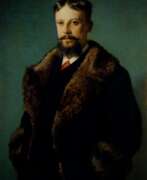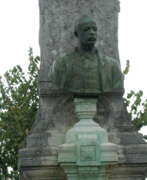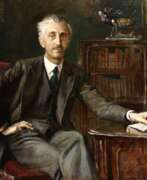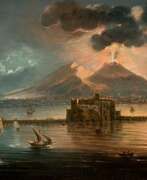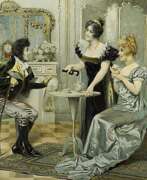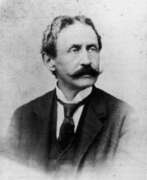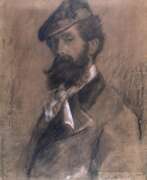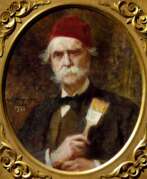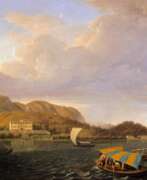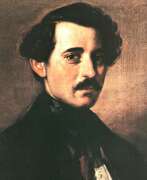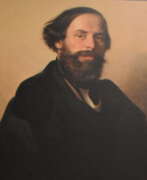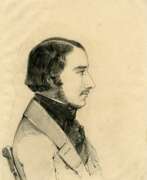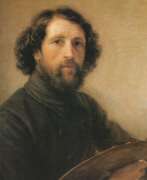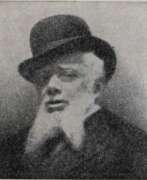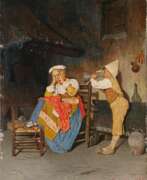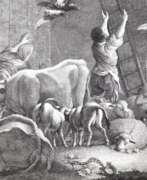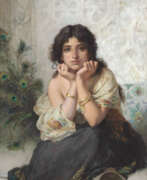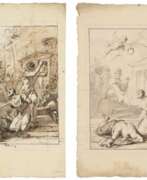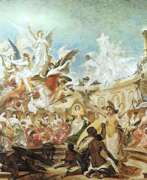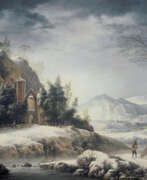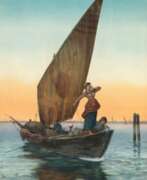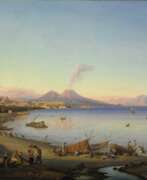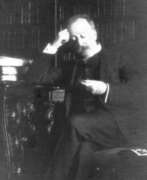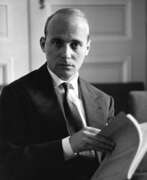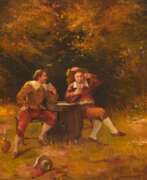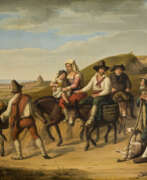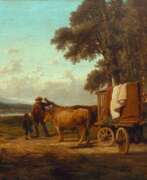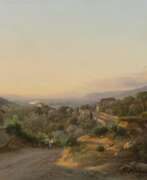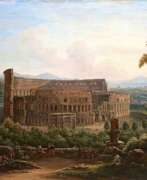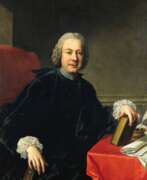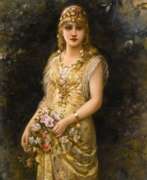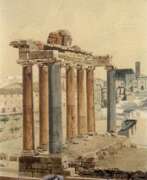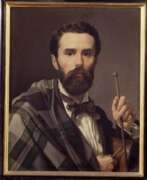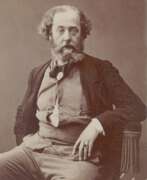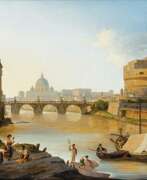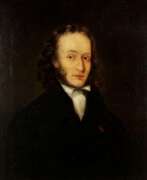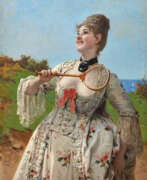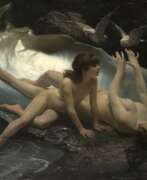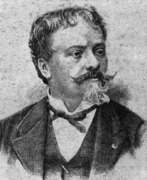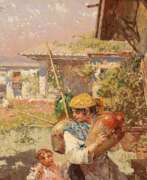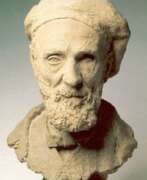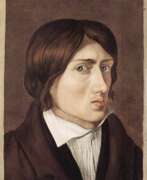Italy Romanticism


Adalbert Franz Eugene Begas is a German painter and portrait painter. In 1862, Adalbert followed his brother, the sculptor Reinhold, to the Grand Ducal Saxon School of Art in Weimar, where he began working in the workshop of Arnold Böcklin.


Giuseppe Bernardino Bison was an Italian painter celebrated for his mastery in frescoes, landscapes, vedute, capriccios, and religious works. Bison's journey through art took him across Italy, leaving a legacy that bridged the 18th and 19th centuries. His education under the tutelage of Gerolamo Romani and Constantino Cedini at the Accademia of Venice laid the foundation for a career influenced by the luminaries of Venetian painting, such as Tiepolo and Francesco Guardi.
Bison's eclectic and versatile style made him a pivotal figure in prolonging the vedutist tradition. His oeuvre includes a significant number of graphic works alongside his frescoes and easel paintings, which often depicted topographical vedutas and fantasy scenes. He worked in various cities, including Ferrara, Trieste, and Padua, leaving behind numerous palaces and villas adorned with his frescoes.
His art found a market among the affluent non-aristocrats of the time, collaborating with art dealer Tosoni to produce landscapes and vedute that catered to local tastes. Despite his success in places like Trieste, Bison's later years in Milan were marked by smaller commissions and financial struggles.
Bison's works are preserved in esteemed collections worldwide, including the Cooper Hewitt, Princeton University Art Museum, University of Michigan Museum of Art, Clark Art Institute, Detroit Institute of Arts, and the Metropolitan Museum of Art, among others. His paintings, such as "The Arsenale in Venice," "The Hermits of Thebes," and "Capriccio of Padua," continue to captivate audiences with their intricate detail and historical value.
For collectors and experts in art and antiques, Bison's legacy offers a unique glimpse into the transition of Italian painting from the 18th to the 19th century. His ability to blend realism with fantastical elements makes his work a fascinating study in the evolution of European art.
For updates on exhibitions, sales, and auctions related to Giuseppe Bernardino Bison's works, sign up for our newsletter. Stay informed on the latest discoveries and opportunities to acquire pieces by this remarkable Italian artist.


Giovanni Boldini was an Italian genre and portrait painter who lived and worked in Paris for most of his career. According to a 1933 article in Time magazine, he was known as the "Master of Swish" because of his flowing style of painting.
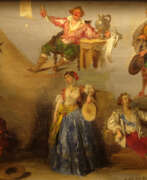

Louis Boulanger was a French Romantic painter, pastellist, lithographer, and poet, celebrated for his contribution to the Romantic Movement and his close associations with notable figures like Victor Hugo. Louis Boulanger's early career was marked by his romantic and allegorical subjects, but it was his shift to more detailed design and classical literature inspiration around 1835 that defined his most productive years. His travels to Spain in 1846 alongside Dumas and others exposed him to the works of masters like Goya and Diego Velázquez, influencing a return to romantic techniques in his later works.
Louis Boulanger's legacy includes the portrayal of several personalities through his portraits, among them George Sand, Victor Hugo, and Petrus Borel, showcasing the influence of various artists including Antoine-Jean Gros and Francisco Goya. Despite some critique for the 'literary' inspiration behind his creations, his pastel sky studies prefigure artists like Paul Huet and Eugène Boudin. Notable works by Louis Boulanger, such as "Supplice de Mazeppa" and "La Ronde du Sabbat," can be found in prestigious French collections, including the Louvre and the Maison de Victor Hugo.
An exhibition titled "Louis Boulanger, peintre rêveur" at the Maison de Victor Hugo, which ran from November 2022 to March 2023, aimed to reintroduce his work, highlighting Boulanger as a central figure in the Romantic circle closely associated with Victor Hugo. This exhibition not only paid tribute to Boulanger but also emphasized his diverse oeuvre, spanning paintings, lithographs, theatrical costume designs, illustrations, and decors, revealing him as one of the main inventors of Romanticism.
If you're interested in the world of art and antiques and wish to stay updated on new product sales and auction events related to Louis Boulanger, signing up for updates is a valuable resource. This subscription will ensure you're informed about the latest opportunities to engage with Boulanger's enduring artistic legacy.


Karl Pavlovich Bryullov (Russian: Карл Па́влович Брюлло́в), a distinguished Russian artist, emerged as a pivotal figure in the world of 19th-century art, blending Western European Romanticism with his Russian heritage to create works that continue to captivate audiences today. His mastery in painting and architecture set him apart, making him a celebrated figure not just in Russia, but across Europe.
Bryullov's acclaim primarily stems from his remarkable ability to infuse his paintings with vibrant life and emotion, a testament to his profound understanding of human expression and the dramatic interplay of light and shadow. His most famous work, "The Last Day of Pompeii," exemplifies this skill, showcasing an epic narrative filled with vivid detail and emotional depth. This masterpiece, which is housed in the State Russian Museum in St. Petersburg, has garnered international praise for its innovative approach to historical painting, merging accuracy with dramatic storytelling.
Beyond "The Last Day of Pompeii," Bryullov's portfolio includes a range of subjects, from majestic portraits to serene landscapes, each bearing his signature blend of realism and romanticism. His works are featured in prestigious galleries worldwide, serving as a testament to his enduring influence on the art world. For collectors and experts in art and antiques, Bryullov's oeuvre offers a fascinating glimpse into the evolution of 19th-century European painting, marked by a unique intersection of culture, art, and history.
For those intrigued by the enduring legacy of Karl Pavlovich Bryullov and his contributions to painting and sculpture, we invite you to sign up for updates. Our subscription service provides exclusive alerts on new product sales and auction events related to this illustrious artist, ensuring that enthusiasts and collectors alike stay informed about opportunities to engage with Bryullov's remarkable works.


Giuseppe Canella, also referred to as Giuseppe Canella the Elder, was an Italian painter.
It may have been under the influence of Pietro Ronzoni, a landscape painter of international renown active in Verona, that he took up landscape painting.
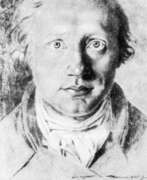

Asmus Jacob Carstens was a Danish-German painter of the late 18th century. He is known as a painter and draughtsman, a representative of classicism and romanticism.
Carstens produced famous narrative and historical paintings, including Plato's Symposium and The Battle of Rossbach, which brought him popularity. His famous huge painting The Fall of Angels, containing 200 figures, made him a professor at the Academy of Fine Arts in Berlin. Carstens preferred pencil, chalk and watercolor, and worked with fresco, rarely using oil. Most of his large-scale projects have been left unfinished or lost. Many of his surviving works exist as drawings.


Francesco Coghetti, an Italian painter, achieved success in the 1830s with numerous awards and commissions from across Europe. Although he declined an offer to direct the Academy of San Carlos in Mexico City in 1844, he later became the President of the Accademia di San Luca. Involved in politics during the annexation of the Papal States, Coghetti faced criticism and was eventually relieved of his teaching duties before his death in 1875.
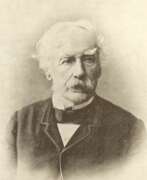

Salomon Corrodi was an Italian-Swiss watercolor painter.
At the age of twenty-two, Corrodi moved from Zurich to Italy, his parents' homeland, and took up the study of watercolor landscape painting in Rome with Jacob Suter (1805-1874). He traveled and painted landscapes extensively, and by the mid-19th century had become a recognized master of watercolor landscape painting as well as a teacher.
Salomon Corrodi lived a long and productive life, laboring until his death and producing many exquisite landscapes of coastal and mountain vistas as well as vedutas. Two of his sons, Herman and Arnold, also became artists.
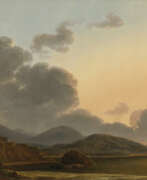

Simon Denis, a Belgian painter, is celebrated for his significant contributions to landscape painting. His journey in art took him from his native Antwerp, where he initially honed his skills under the tutelage of landscape and animal painter H.-J. Antonissen, to the bustling artistic scenes of Paris and ultimately to Italy, where he spent the majority of his career.
Denis's move to Rome in 1786, facilitated by the support of genre painter and art dealer Jean-Baptiste-Pierre Lebrun, marked the beginning of a prolific period in which his work attracted favorable attention. His marriage to a local woman in 1787 and his active participation in both the Flemish and French artistic communities in Rome underscore his integration into and influence on the local art scene. Notably, his technique was characterized by an exact and detailed approach, especially in his depictions of famous Italian landscapes, such as the waterfalls of Tivoli near Rome. This meticulous attention to naturalistic details and light effects distinguished his work during his time in Italy.
Denis's election to the prestigious Accademia di San Luca in 1803 attests to his recognition among his peers. In 1806, he settled in Naples, where he became the court painter to Joseph Bonaparte and later a professor at the Accademia di Belle Arti. His influence extended to teaching, with landscape painter Prosper Barrigue de Fontainieu among his pupils, demonstrating his role in shaping the next generation of artists.
Simon Denis's works, including "Study of Clouds with a Sunset near Rome" and "Landscape near Rome during a Storm," are held in prestigious collections such as the J. Paul Getty Museum and The Metropolitan Museum of Art, ensuring his lasting legacy in the annals of art history. For collectors and experts in art and antiques, Denis's oeuvre offers a window into the evolution of landscape painting, characterized by an immersive exploration of nature and meticulous attention to atmospheric effects.
To stay informed about new discoveries, sales, and auctions related to Simon Denis's works, signing up for our newsletter is recommended. This subscription is an invaluable resource for those looking to deepen their understanding of Denis's impact on landscape painting and to keep abreast of opportunities to acquire pieces by this masterful Belgian artist.


Francesco Fidanza is an Italian landscape painter.
The main theme of the artist's work is the greatness and beauty of nature. Fidanza painted seascapes of the Mediterranean with storm clouds, views of snow-covered coastal cliffs, depicted the erupting Vesuvius; nature in his paintings lives and breathes.


Carl Philipp Fohr was a German painter of the early 19th century. He is known as a landscape painter and is considered a key figure of German Romanticism in painting.
Fohr trained in Italy, where early in his career he interacted for a time with the Nazarenes. His own style gradually developed and he produced significant works, including a group portrait of German artists in Rome. His younger brother, Daniel Faure, was also a noted landscape painter and court painter to the Grand Duke of Baden.
Carl Philipp Fohr passed away at a young age, but left a deep mark on the history of art.


Girolamo Franceschini was an Italian theater artist, draftsman, and lithographer who worked in Austria.
From 1848-1859 Franceschini worked as a costume designer for two court theaters in Vienna, designing original costumes for many plays and operas. Franceschini was also for a time a contributor to the Illustrated Theater Newspaper there and published numerous series of illustrations.
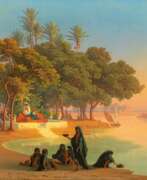

Johann Jakob Frey was a Swiss landscape painter.
Johann Jakob Frey travelled extensively in Italy, especially in and around Rome, making landscape sketches. In his studio he used these sketches to create paintings. He also traveled to Spain and Egypt to sketch for later works.
Frey's pictorial style is based on paintings by Josef Koch or Franz Horny. For example, they often feature a richly detailed foreground, which often shows elements such as winding paths or rivers drawing the viewer's attention away.


Nikolai Nikolaevich Ge (Russian: Николай Николаевич Ге) was a distinguished Russian painter, whose contributions to the world of art are celebrated for their emotional depth and philosophical introspection. Born in 1831, Ge's work spans a variety of themes, including religious, historical, and psychological subjects, making him a versatile artist in the realm of 19th-century Russian culture. His paintings are known not just for their aesthetic appeal but also for their ability to provoke thought and evoke deep emotions.
Ge's art is marked by its intense exploration of moral and spiritual questions, distinguishing him from his contemporaries. One of his most famous works, "The Last Supper" (1863), showcases his ability to infuse traditional religious scenes with a new level of emotional intensity and humanism. This painting, along with others like "Christ in the Garden of Gethsemane" (1868), reflects Ge's deep engagement with the themes of suffering, redemption, and the human condition. His approach to these universal subjects has earned him a special place in the canon of Russian art, making his works highly sought after by collectors and experts in art and antiques.
Ge's contributions to art extend beyond his individual works. His commitment to portraying the human experience with honesty and depth has influenced generations of artists. His paintings can be found in prestigious galleries and museums, serving as a testament to his enduring legacy. For collectors and art aficionados, Ge's work represents not only an investment in Russian culture and history but also an ongoing exploration of the depths of human emotion and spirituality.
For those interested in the profound and moving art of Nikolai Nikolaevich Ge, staying informed about new discoveries, sales, and auction events related to his work is essential. Sign up for updates to ensure you never miss an opportunity to engage with the legacy of this remarkable artist. This subscription will exclusively alert you to new product sales and auction events related to Nikolai Nikolaevich Ge, keeping you connected to the very best of Russian art and culture.
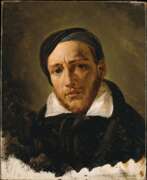

Jean-Louis André Théodore Géricault was a French painter and lithographer, celebrated for his pivotal role in the Romantic movement. Born in Rouen, France, in 1791, and educated among the elite in Paris, Géricault developed a profound connection with art from a young age, influenced by his training under notable figures like Carle Vernet and Pierre-Narcisse Guérin. This foundation set him on a path that diverged significantly from the classical traditions of his time.
Géricault's artistry is best known for its vibrant energy and emotional intensity, characteristics that marked a departure from the Neoclassical style predominant in the early 19th century. His most famous work, "The Raft of the Medusa" (1818–19), is a monumental canvas that dramatizes the tragic aftermath of the French shipwreck, Méduse, capturing the public and critical imagination for its raw portrayal of human despair and resilience. This painting not only criticized the French government but also showcased Géricault's masterful handling of drama, becoming an iconic symbol of Romanticism.
Throughout his career, Géricault remained deeply engaged with contemporary issues and the human condition, exploring themes of mental illness, social injustice, and the raw power of nature versus human vulnerability. His series of portraits depicting patients with mental illnesses, created towards the end of his life, highlighted his empathy and innovative approach to capturing human emotion and psychological depth.
Géricault's fascination with the dynamic forms and emotional potential of horses also led to some of the most stirring equestrian art of his time, reflecting his personal passion for horseback riding and his exceptional understanding of equine anatomy. This interest is evident in works like "A Horse Frightened by Lightning", showcasing his ability to capture motion and emotion in both human and animal forms.
Despite his premature death at the age of 32, Géricault's legacy endures, with his works residing in prestigious institutions like the Louvre in Paris. His artistic vision and dedication to portraying the realities and turbulences of his era have cemented his status as a pioneer of Romanticism, influencing subsequent generations of artists, including his contemporary and friend, Eugène Delacroix.
For collectors and experts in art and antiques, Géricault's oeuvre offers a profound insight into the Romantic spirit, embodying the tumult, passion, and innovation of an era on the cusp of modernity. His works continue to inspire and captivate audiences, reminding us of the power of art to provoke thought and evoke deep emotional responses.
To stay updated on exhibitions and auction events featuring Géricault's works, sign up for updates. This subscription will keep you informed on new discoveries and sales related to this influential artist, ensuring you never miss an opportunity to engage with the legacy of Jean-Louis André Théodore Géricault.


Marco Gozzi was an Italian landscape art painter.
Gozzi worked initially in a broad range of fields including portraiture, religious subjects and decorative frescoes executed in accordance with the Veneto tradition, then still predominant in the region of Bergamo.
While he never held the chair in landscape at the Academy of Brera, he was elected an honorary member in 1829 and qualified as a landscape painter in 1832.


Johann Georg Grimm was a German painter of the mid-nineteenth century. He is known as a landscape painter and designer, most famous for his works created during his stay in the Brazilian Empire.
Georg Grimm is recognized as the preeminent master of Brazilian art and is considered a leader of modernism in that country. He had a significant influence on the development of modern painting in Brazil, founding a plein air school and becoming a teacher. His naturalistic landscapes are recognized as a valuable legacy and many are in private collections. In Germany he remained little known.
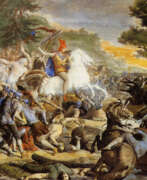

Friedrich Gunkel was a German painter. Gunkel studied at the Academy in Kassel. Here he was a student of Ludwig Emil Grimm and Friedrich Wilhelm Müller and was soon considered the best student in the drawing class. He went to Berlin and worked in the studio of Peter von Cornelius as his assistant. From May 9, 1847, he lived in Rome as a German Roman and became a member of the German Association of Artists. In 1856 he formed a community with the sculptors Gustav Kaupert and Heinrich Gerhardt and the painter Heinrich Dreber. Gunkel's most famous work was the Hermannsschlacht, a monumental history painting that the Bavarian King Maximilian II had commissioned in 1857 for the Maximilianeum and that Gunkel completed in Munich between 1862 and 1864. Destroyed in World War II, it survives only in photographs and reproductions.
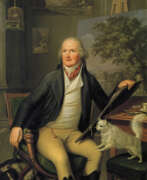

Jakob Philipp Hackert was a German painter of the second half of the 18th and early 19th centuries. He is known as a landscape painter and printmaker, a representative of neoclassicism and romanticism.
Hackert reached the peak of creative activity in 1770-1780. He was recognized by the European aristocracy, and for a time served as court painter to King Ferdinand IV of Naples, as well as receiving commissions from representatives of the Russian imperial family, such as Empress Catherine II and the heir to the throne, Paul Petrovich. His work, according to critics, was characterized by high craftsmanship and aristocratic elegance.
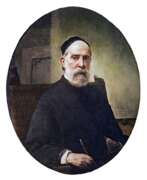

Francesco Hayez was an Italian painter, considered one of the leading artists of Romanticism in Italy in the mid-19th century.
He showed talent as an artist early on, studying painting in Rome and at the Venice Academy. Arriving in Milan in 1823, he quickly established himself at the center of the intellectual and aristocratic life of the city. Hayez created grandiose paintings of historical subjects with a patriotic context, popular biblical scenes and plots from classical literature. The artist loved political allegories as well. He also painted portraits, subtly reflecting the characters of the people portrayed.
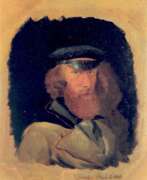

Paul Kane was a nineteenth-century Canadian artist of Irish descent. He is known as a master of portrait, landscape and domestic genres. Paul Kane mainly painted paintings depicting the daily life of North American Indians, and his work is still the subject of study by professional ethnological scholars.
Paul Kane, a self-taught artist, studied painting while traveling in Europe. His fateful trip was to London, where, under the influence of the famous artist George Catlin, he decided to devote his career to describing the life of the North American Indians. Kane traveled extensively across Canada, producing hundreds of sketches and an illustrated book that became a bestseller and was translated into many European languages.
Paul Kane's work is considered an important part of Canada's cultural heritage. In February 2002, Kane's painting Scene in the Northwest was sold at Sotheby's in Toronto for more than $5 million, roughly 10 times the sale price of the artist's previous painting.


Orest Adamovich Kiprensky (Russian: Орест Адамович Кипренский) emerged as a masterful Russian portraitist in the Age of Romanticism. His journey from an illegitimate serf background to a celebrated artist is a testament to his extraordinary talent and determination. Kiprensky's early exposure to art at the St. Petersburg Academy of Arts paved the way for his signature style, marked by emotional depth and technical brilliance.
Orest Kiprensky's works resonate with the spirit of Romanticism, capturing the essence of his subjects with remarkable sensitivity and nuance. His portrait of Alexander Pushkin is among his most famous, celebrated for its vivid portrayal of the poet's character. Kiprensky's life was as dramatic and varied as his art, with significant periods spent in Italy, where he immersed himself in the local culture and art scene, eventually marrying and converting to Roman Catholicism.
His legacy is enshrined in numerous galleries, where his portraits continue to captivate audiences with their expressive intensity and elegance. Orest Kiprensky's ability to capture the soul of his subjects on canvas ensures his enduring status as a pivotal figure in Russian Romantic art.
For those fascinated by Orest Kiprensky's life and work and keen on updates related to his art, including exhibitions and sales, subscribing to relevant updates can provide valuable insights into the world of this distinguished portraitist.


Hendrikus Johannes Knip or Henri Knip was a Dutch and Belgian landscape painter in the style of Dutch Romanticism and a draftsman.
A member of the Knip artistic dynasty: his father was the painter Matthäus Derk Knip (1785-1845), his grandfather was the painter Nicolaas Frederik Knip, and his uncles and aunts were also painters.
Hendrikus Knip worked in the Netherlands, Belgium, Italy and Switzerland.


Joseph Anton Koch was an Austrian painter, draughtsman and printmaker, master of etching and illustration, novelist and representative of the classicist landscape in German art. In his native country he was associated with the Biedermeier aesthetic, and in Rome with the Nazarene society.


Jan (Johan) Philip Koelman was a Dutch painter, sculptor, writer and teacher. He attended Cornelis Kruseman's studio together with other artists of this period, such as Alexander Hugo Bakker Korff, David Bles and Herman ten Kate. Between 1846 and 1851 Koelman lived in Rome, to where he travelled for artistic purposes.
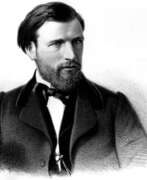

Lev Feliksovich Lagorio (Russian: Лев Феликсович Лагорио) was a Russian painter known for his exquisite seascapes and coastal landscapes. Born in 1827 in Feodosia, Crimea, Lagorio's Italian heritage and Russian upbringing greatly influenced his artistic style.
Lagorio's paintings are celebrated for their vibrant use of color and meticulous attention to detail, capturing the dynamic beauty of the sea and coastal environments. His works often depict serene seascapes, bustling ports, and dramatic coastal scenes, showcasing his ability to convey both tranquility and movement in nature. His technique involved capturing the subtle interplay of light and shadow, giving his paintings a lifelike quality.
Some of Lagorio's notable works include "View of the Caucasus Mountains from the Sea" and "Storm on the Black Sea," which are housed in prestigious institutions such as the State Russian Museum in St. Petersburg. Collectors and art enthusiasts highly value his contributions to maritime art.
For those interested in exploring the works of Lev Feliksovich Lagorio, signing up for updates on upcoming auctions and sales can provide exclusive access to new opportunities. Stay informed about the latest offerings by subscribing to our newsletter focused on Lagorio's masterpieces.
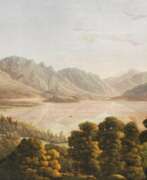

Federico Lose was a German landscape painter who worked in Italy.
In 1814 Federico Lose and his wife Caroline (maiden name von Schlieben) moved to Milan, and together they worked for several publishers. Carolina was mainly engaged in engraving her husband's drawings. Among other works, they compiled an illustrated guide to the province of Brianza, located between Milan and Lake Como in Italy. As well as the series "Twenty-five Views of Milan and its Environs", where the artist, in addition to landscapes, depicted a cross-section of everyday life in Milan in the first half of the 19th century.


Caroline Lose, maiden name Caroline von Schlieben, was a German painter, draughtswoman and engraver who worked in Italy.
Together with her husband, the painter Federico Lose (1776-1833), she moved to Milan and from 1815 they worked together for several publishers. Caroline first worked in textile jewelry, then devoted herself almost exclusively to printmaking, translating her husband's drawings into engravings. Among other works, they produced an illustrated guide to the province of Brianza, located between Milan and Lake Como in Italy. As well as the series "Twenty-five Views of Milan and its Environs", where the artist, in addition to landscapes, depicted a cross-section of the everyday life of Milanese in the first half of the 19th century.
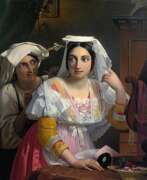

Jan Baptist Lodewyck Maes was a Belgian genre painter active in Italy. Maes studied at the Academy of Ghent. He exhibited for the first time at that city's fair in 1810. He won prizes in all the competitions he entered and in 1820 received a grant from the city of Ghent. Thanks to the Belgian Rome Prize received in 1821, he first visited Paris and then went on to Italy. In 1822 he copied works by old masters in the Uffizi Museum. In 1824 he settled in Rome. Maes kept in touch with his hometown and regularly sent works to Belgian salons. He was a corresponding member of the Royal Netherlands Academy of Sciences.


Adrien Manglard was a French marine painter and printmaker who worked most of his life in Italy.
He was a member of the Royal Academy of Painting and Sculpture of France. The artist mainly painted coastal landscapes with ships and sailing ships. As a very skilled marine landscape painter, Manglard was very successful and in demand, and had many commissions for paintings.
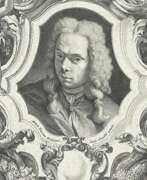

Michele Marieschi was an Italian painter, known for his landscape and cityscape paintings, primarily of Venice. Born in 1696, Marieschi was a pivotal figure in the veduta genre, a style focusing on detailed and often idealized representations of cityscapes. His works are celebrated for their architectural detail and the lively, fresh use of paint, distinguishing him from his contemporaries like Canaletto. Michele Marieschi's paintings often featured exaggerated perspectives, infusing scenes from life with the novelty of capricious invention.
His career included a significant period from 1735 to 1741 when he was registered with the Venetian painters' guild, indicating his recognition and establishment within the Venetian art community. In 1741, Marieschi published a set of 21 prints of Venice, providing a lasting legacy of his perspective on the city's unique landscape. This collection, titled "Magnificentiores Selectioresque Urbis Venetiarum Prospectus," included a self-portrait, underscoring his role in documenting Venice's architectural splendor.
Michele Marieschi's approach to vedute was influenced by his early work in scenery painting, allowing him to create urban views marked by an inventive use of perspective. This stylistic choice offered a new dimension to scenes taken from life, setting Marieschi apart from his peers.
For collectors and experts in art and antiques, Michele Marieschi's works represent a unique blend of architectural precision and imaginative composition. His influence on later painters, including Francesco Guardi, underscores his importance in the development of the veduta genre.
To stay informed about new discoveries, sales, and auction events related to Michele Marieschi's work, signing up for updates from relevant art institutions and auction houses is recommended. This subscription ensures that enthusiasts and collectors remain abreast of the latest developments related to this master of the Italian cityscape.
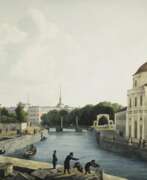

Andrey Efimovich Martynov (Russian: Андрей Ефимович Мартынов) was a Russian painter and engraver, known for his landscapes and lithographs. Born in 1768 in St. Petersburg, he graduated from the Imperial Academy of Arts in 1788. Martynov studied landscape painting under Semion Shchedrin and further honed his skills in Italy from 1788 to 1794, under the influence of Jakob Philipp Hackert. His Italian landscapes were highly appreciated upon his return to Russia, leading to his appointment as an academician in 1795.
Martynov’s work is renowned for its idealized and panoramic views of nature. He traveled extensively, capturing the beauty of rural Russia, Siberia, and Mongolia in his watercolors and lithographs. His series "Views of Russia and Mongolia" and "Peoples Types of Russia and Mongolia" are particularly admired for their detail and artistic quality. Martynov was also the official artist of the Russian embassy to China in 1805, a role that further enriched his portfolio with diverse cultural landscapes.
In addition to painting, Martynov contributed significantly to the development of lithography in Russia. His works, including scenes from the Crimea, the Baltic States, and the Volga River, are preserved in various museums, such as the Russian Museum and the Museum of the Academy of Fine Arts. Martynov’s legacy lies in his ability to blend classical composition with the celebration of natural beauty, making his works a valuable part of Russian art history.
To stay updated on new arrivals and auction events related to Andrey Efimovich Martynov, sign up for our updates. This subscription will only notify you about new product sales and auction events.
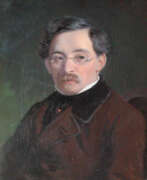

Ernst Meyer was a Danish genre painter of Jewish origin. He studied painting at the Royal Danish Academy of Arts.
Ernst Meyer travelled extensively, living for a time in Germany, France, Switzerland and Italy. It was the colourful street life of Rome that first inspired him to create genre scenes.
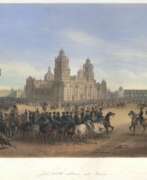

Carl Nebel was a German painter of the mid-nineteenth century. He is known as an architect, painter, graphic artist and draftsman.
Nebel became famous for his lithographs depicting various social and ethnic groups in Mexico. In 1836, he published his famous illustrated book in Paris, which included 50 lithographs of his paintings and drawings. In 1851, Nebel contributed to the publication of The War Between the United States and Mexico, which featured his battle drawings from the American-Mexican War.


Friedrich von Nerly was a German Romantic painter and collector. He is known for his vedotes from Venice. He is sometimes called 'the Elder' to distinguish him from his son, the painter Friedrich Paul Nerly.
In 1883 his entire art collection was donated to the city of Erfurt by his son Friedrich on the condition that it would be used to create a museum. This was done and the Angermuseum opened in 1886.


Friedrich Paul Nerly was a German landscape painter. He studied painting with his father, Friedrich Nerly, and at the Academy of Fine Arts in Venice with Professor Eugène de Blaas.
The main themes of Friedrich Paul Nerly's work were Italian port, beach and cityscapes (sunset in the Adriatic Sea, the White Grotto in Capri, the surf on the Amalfi coast, the beach between Ancona and Falconara).
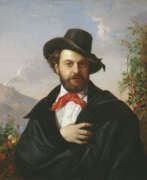

Pimen Nikitich Orlov (Russian: Пи́мен Ники́тич Орлóв) was a Russian painter renowned for his mastery in the Classical style, celebrated for his artistry across various genres throughout his predominant career in Italy. Born into a miller's family in 1812 near Malo-Foshchevaty, Orlov displayed an early aptitude for drawing, despite the financial challenges that initially hindered his artistic education. His persistence led him to apprentice under a traveling decorative painter, ultimately facilitating his formal studies at the Imperial Academy of Arts under the guidance of Karl Bryullov.
Orlov's works are distinguished by their delicate color treatment and effective lighting, capturing the essence of his subjects with a thorough finish. His portfolio predominantly features portraits and genre scenes reflective of Italian life, though he also ventured into historical subjects and landscapes. Notable works include "Young Roman Girl at the Fountain" and "Italian Morning," both of which were acquired by Emperor Nicholas I, underscoring the demand for his art in Russia.
Many of Orlov's paintings are housed in prestigious collections across Russia and the CIS, including the Tretyakov Gallery and the Tver Regional Picture Gallery, among others. His legacy continues to be celebrated, affirming his status as a significant figure in 19th-century Russian art.
For those interested in exploring the works of Pimen Nikitich Orlov or staying updated on sales and auction events featuring his art, signing up for our newsletter provides an excellent opportunity to connect with this classical master's enduring appeal.


Francesco Peluso was an Italian painter. He is known for his genre paintings and portraits, which were often inspired by everyday life and culture in Naples.
Peluso had a realistic and naturalistic approach to painting. His paintings often depicted scenes of everyday life in Naples, including street vendors, musicians and local festivals. Peluso was particularly adept at conveying the vivid colours and atmosphere of the city, and his works are known for their warm, sunny palette and sense of spontaneity.
In addition to genre paintings, Peluso also produced a number of portraits, many of which were commissioned by members of the Italian nobility. His portraits are noted for their attention to detail and psychological insight into the character and personality of the subject.


Giovanni Battista Piranesi was an 18th-century Italian painter, engraver, architect, and archaeologist who represented Neoclassicism and Romanticism. He was famous for creating a lot of original etchings with images of antique architecture monuments.
Giovanni Piranesi created hundreds of drawings and drafts in which he depicted the reconstructed ruins of ancient Roman buildings. His works are still used as teaching aids in the education of architectural students in many prestigious European universities. Piranesi periodically printed voluminous books with dozens of his own engravings depicting modified ancient architectural masterpieces - "graphic fantasies". His works were in demand among professional architects, who borrowed Piranesi's original ideas for their designs.
The peak of Piranesi's career came in the 1760s when, in recognition of his merits, he became an honorary member of the Guild of St. Luke and received from the Pope the title of Knight of the Golden Spur.
More than 700 of the master's original etchings have survived, printed in scholarly works.
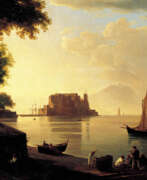

Antonie or Anton Sminck Pitloo was a Dutch painter. His surname was originally Pitlo, but he added the extra "o" because he was often mistaken for an Italian while resident in Italy. In Italian he is also known as Antonio van Pitloo.
He was considered a leading exponent of the "Posillipo School" of painting, named to the area where he lived in Naples. His paintings have been compared to precursors of Impressionism, some sixty years before this was invented.
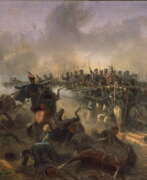

Raffaele Pontremoli was an Italian painter, engraver and military man and the official portraitist of Vittorio Emanuele II.
Together with Girolamo Induno and Giovanni Fattori, he is one of the main representatives of the "artist of the soldier", as well as one of the greatest military painters. He is also one of the greatest representatives of Italian Risorgimento painting. He was inspector general of the Pinacoteca Brera from 1882 to 1906.
Rafael Pontremoli studied painting at the Academy of Arts in Nice and at the Albertina Academy in Turin.
During the Second Italian War of Independence he worked as a correspondent and created many accurate artistic descriptions of battle episodes.


